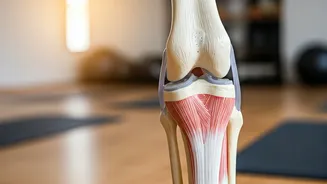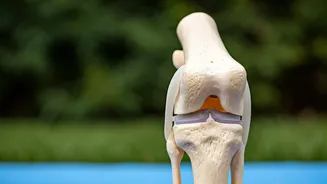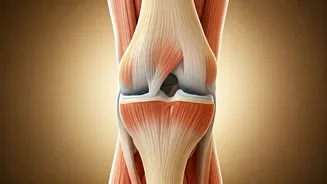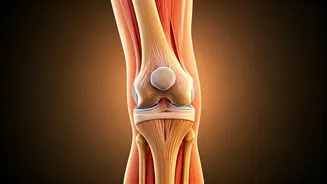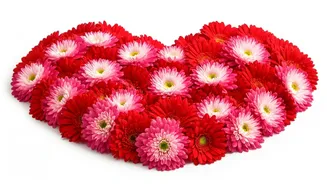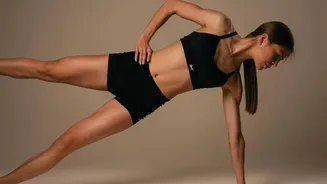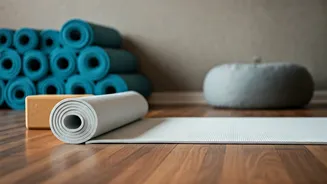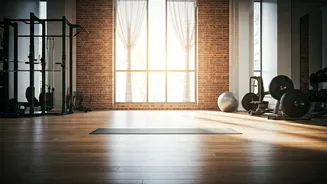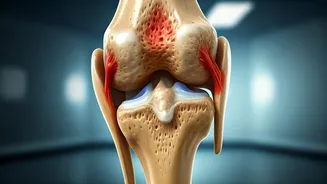Understanding Knee Health
Knee health is crucial for overall mobility and quality of life, often underestimated until pain and stiffness set in. The knees are complex joints, bearing
the brunt of daily activities such as walking, running, and even standing. Problems can arise from various factors, including overuse, injury, and age-related wear and tear. A proactive approach to knee health, incorporating exercise, proper posture, and a healthy lifestyle, is vital. Yoga provides a low-impact yet effective method for addressing common knee issues, offering both preventative and rehabilitative benefits. Practicing yoga asanas can improve joint lubrication, increase the range of motion, and strengthen the muscles surrounding the knees, ultimately supporting better knee function and reducing pain. It's a holistic approach, addressing not only the physical aspects but also promoting relaxation and reducing stress, which can indirectly contribute to improved joint health.
Tadasana (Mountain Pose)
Tadasana, or Mountain Pose, might seem basic, but it forms the foundation for many yoga poses and actively engages the legs and knees. To perform it correctly, stand with your feet together or slightly apart, grounding yourself through all four corners of your feet. Engage your leg muscles, pulling your kneecaps up without locking your knees. Keep your spine straight and lengthen your tailbone towards the floor. Your shoulders should be relaxed, and your arms at your sides. The focus here is on proper alignment, which strengthens the supporting muscles and enhances balance, thereby stabilizing the knees. Regular practice of Tadasana helps build awareness of your body position, enabling you to identify and correct any imbalances or misalignments that could put undue stress on the knees. It sets the stage for more complex asanas by teaching body awareness and control, making it an excellent starting point for any yoga practice aimed at knee health.
Trikonasana (Triangle Pose)
Trikonasana, or Triangle Pose, is excellent for stretching the sides of the body and strengthening the legs. Begin by standing with your feet wide apart, about three to four feet. Turn your right foot out 90 degrees and your left foot slightly inward. Inhale deeply, and as you exhale, extend your right arm toward your right leg, then bend at your hip, reaching your hand towards your shin or the floor. Keep your back straight, and extend your left arm towards the ceiling. Gaze up at your upper hand or straight ahead. This pose not only stretches the hamstrings and hip flexors but also strengthens the quadriceps and inner thigh muscles, offering crucial support for the knees. As you move into Trikonasana, pay close attention to your knee alignment – ensure the knee of the bent leg is directly over your ankle. Avoid overextending the knee, which can strain the joint. It is advisable to modify the pose using a block for the hand if necessary, to ensure proper alignment and avoid injury.
Virabhadrasana II (Warrior II)
Virabhadrasana II, also known as Warrior II, is a dynamic pose that fortifies the legs and opens the hips. Stand with your feet wide apart, about the distance of your legs. Turn your right foot out 90 degrees and your left foot slightly inward. Bend your right knee until it is directly over your ankle, ensuring your thigh is parallel to the floor. Extend your arms out to the sides, parallel to the ground, with your palms facing down. Gaze over your right hand. This pose builds strength in the quads, hamstrings, and calves, all of which are essential for supporting the knees. The hip-opening aspect can also relieve tension, contributing to improved joint function. Maintaining proper knee alignment is crucial in Warrior II. Avoid letting your knee drift inward or extend beyond your ankle; this can put stress on the knee. Consciously engage your leg muscles to keep the knee in alignment, providing stability and protection to the joint. Modifications are possible; for example, if your knee is strained, you can adjust the depth of the lunge.
Ardha Uttanasana (Half Forward Bend)
Ardha Uttanasana, or Half Forward Bend, is a simple yet beneficial pose that helps to lengthen the spine and stretch the hamstrings. Start in Tadasana, and as you inhale, raise your arms overhead. As you exhale, bend forward from your hips, keeping your back straight. Place your hands on the floor in front of your feet. You can either keep your hands on the floor or rest them on your shins. The key here is to keep your back straight. This pose can help to release tension in the hamstrings, which, when tight, can pull on the knee joint and cause pain. By lengthening the spine and promoting a healthy posture, Ardha Uttanasana indirectly benefits the knees. It encourages better alignment throughout the body, reducing the overall stress on the joints. If you feel any strain in your knees, it's advised to keep a slight bend in the knees during the pose to prevent hyperextension.
Setu Bandhasana (Bridge Pose)
Setu Bandhasana, or Bridge Pose, is a gentle backbend that strengthens the back muscles and stretches the front of the body, including the hip flexors. Lie on your back with your knees bent and feet flat on the floor, hip-width apart. Place your arms at your sides, palms facing down. Inhale and lift your hips off the floor, keeping your shoulders on the ground. You can clasp your hands beneath your body for added support or keep your hands flat on the floor. This pose strengthens the glutes and hamstrings, which support the knees, and stretches the front of the thighs. Bridge Pose can help to alleviate knee pain by improving the alignment of the pelvis and promoting circulation. Ensure your knees do not splay out to the sides; keep them aligned with your feet. Consciously engage your core to support your lower back and prevent any strain. By incorporating Setu Bandhasana into your routine, you contribute to overall joint health and well-being, enhancing both flexibility and strength.
